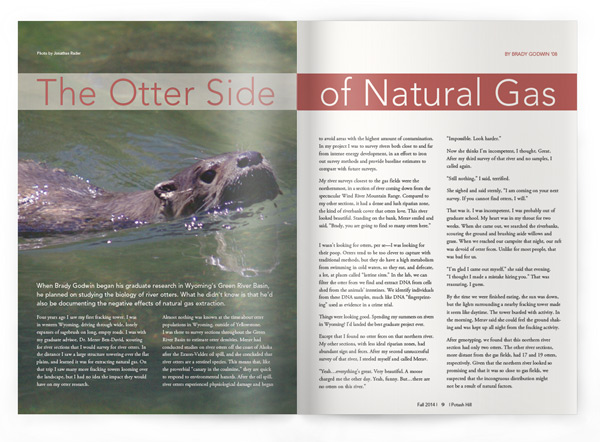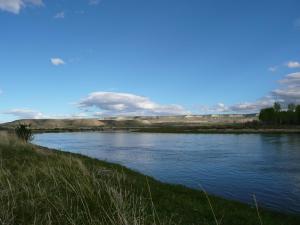The Otter Side of Natural Gas

By Brady Godwin ’08
Photo by Jonathan Rader
When Brady Godwin began his graduate research in Wyoming’s Green River Basin, he planned on studying the biology of river otters. What he didn’t know is that he’d also be documenting the negative effects of natural gas extraction.
Four years ago I saw my first fracking tower. I was in western Wyoming, driving through wide, lonely expanses of sagebrush on long, empty roads. I was with my graduate advisor, Dr. Merav Ben-David, scouting for river sections that I would survey for river otters. In the distance I saw a large structure towering over the flat plains, and learned it was for extracting natural gas. On that trip I saw many more fracking towers looming over the landscape, but I had no idea the impact they would have on my otter research.

Almost nothing was known at the time about otter populations in Wyoming, outside of Yellowstone. I was there to survey sections throughout the Green River Basin to estimate otter densities. Merav had conducted studies on river otters off the coast of Alaska after the Exxon-Valdez oil spill, and she concluded that river otters are a sentinel species. This means that, like the proverbial “canary in the coalmine,” they are quick to respond to environmental hazards. After the oil spill, river otters experienced physiological damage and began to avoid areas with the highest amount of contamination. In my project I was to survey rivers both close to and far from intense energy development, in an effort to iron out survey methods and provide baseline estimates to compare with future surveys.
My river surveys closest to the gas fields were the northernmost, in a section of river coming down from the spectacular Wind River Mountain Range. Compared to my other sections, it had a dense and lush riparian zone, the kind of riverbank cover that otters love. This river looked beautiful. Standing on the bank, Merav smiled and said, “Brady, you are going to find so many otters here.”
I wasn’t looking for otters, per se—I was looking for their poop. Otters tend to be too clever to capture with traditional methods, but they do have a high metabolism from swimming in cold waters, so they eat, and defecate, a lot, at places called “latrine sites.” In the lab, we can filter the otter feces we find and extract DNA from cells shed from the animals’ intestines. We identify individuals from these DNA samples, much like DNA “fingerprinting” used as evidence in a crime trial.
Things were looking good. Spending my summers on rivers in Wyoming? I’d landed the best graduate project ever.
Except that I found no otter feces on that northern river. My other sections, with less ideal riparian zones, had abundant sign and feces. After my second unsuccessful survey of that river, I steeled myself and called Merav.
“Yeah…everything’s great. Very beautiful. A moose charged me the other day. Yeah, funny. But…there are no otters on this river.”
“Impossible. Look harder.”
Now she thinks I’m incompetent, I thought. Great. After my third survey of that river and no samples, I called again.
“Still nothing,” I said, terrified.

She sighed and said sternly, “I am coming on your next survey. If you cannot find otters, I will.”
That was it. I was incompetent. I was probably out of graduate school. My heart was in my throat for two weeks. When she came out, we searched the riverbanks, scouring the ground and brushing aside willows and grass. When we reached our campsite that night, our raft was devoid of otter feces. Unlike for most people, that was bad for us.
“I’m glad I came out myself,” she said that evening. “I thought I made a mistake hiring you.” That was reassuring, I guess.
By the time we were finished eating, the sun was down, but the lights surrounding a nearby fracking tower made it seem like daytime. The tower bustled with activity. In the morning, Merav said she could feel the ground shaking and was kept up all night from the fracking activity.
After genotyping, we found that this northern river section had only two otters. The other river sections, more distant from the gas fields, had 17 and 19 otters, respectively. Given that the northern river looked so promising and that it was so close to gas fields, we suspected that the incongruous distribution might not be a result of natural factors.
Proponents of fracking point to benefits such as how clean natural gas is compared to other fossil fuels, how extraction within the U.S. reduces our dependence on foreign sources of energy, and how it creates jobs. Dissenters argue that energy companies don’t disclose the chemicals used in the process, and don’t acknowledge the damage those chemicals could cause to the environment. We don’t know what’s being pumped into our ground, and there are no federal laws forcing companies to disclose any of it.
Fracking is a simple process, conceptually, typically involving a cement-cased hole reaching around 10,000 feet below the surface, well below any aquifer. However, the lubricants, surfactants, and other chemicals used are nasty. A scientist in Colorado identified over 700 chemicals in use, more than 75 percent of which are known to be toxic: carcinogens, endocrine disruptors, neurotoxins…they aren’t nice. Many states now require energy companies to disclose chemicals used in fracking, and Wyoming was the first to do so. Still, some chemicals remain secret for proprietary reasons, and companies don’t have to disclose the amounts or combinations of chemicals used.
I suspected that fracking activities, and possible surface water contamination, might have been causing the variation in otter distribution we observed. But I couldn’t jump to that conclusion. I had to rule out other variables. What could be important to otters? Riparian zone habitat? I found no significant difference among sections. Prey availability? Surveys by the Wyoming Game and Fish Department found no difference. Human-caused disturbance? There are GIS data that quantify this—again, no real difference. We found results that suggested otters might be simply avoiding the noise of fracking activities, but that’s difficult to accurately quantify.

Finally, I put conductivity loggers in the rivers I surveyed. Water itself barely has a charge, but many particles in water do: that’s what conductivity measures. Some chemicals used in fracking are very saline and have a strong ionic charge. An unusually high conductivity could indicate pollutants. That’s exactly what I found.
I put two loggers in my northernmost river, two miles apart—between those loggers were extraction operations close to the river. The loggers documented that over a period of approximately five months more than 5,600 tons of “salt-equivalents” were added to that section of river. The actual tonnage would vary if the particles did not have the same ionic charge as salt, but even then, that’s a lot. No expert I’ve spoken with can explain this temporal pattern based on natural geology, limnology, or weather events.
Unfortunately, I was not able to identify specific pollutants in the water; my proposals for funding those analyses were denied. I can’t definitively say what the 5,600 tons of salt-equivalents were, or even that they were anthropogenic in origin. However, my otter results and preliminary work on pollutants will hopefully provide support for thorough testing of surface waters near areas of natural gas extraction.
Reports of fracking operations possibly contaminating ecosystems are growing. Energy demands will continue to increase, and I know that preservation and conservation are not priorities for many people, which makes challenging these practices difficult. Perhaps I’ve become a rather fatalistic environmentalist in that regard, but what I do stand against is lax regulation of a large-scale and potentially damaging practice.
Fracking seems to have operated largely outside of regulation—I believe that is starting to change. My otter ecology research is one very small regional piece of a very large national issue. But at the very least, the results of my work give us more reason to seriously investigate industrial regulations and practices concerning surface water quality. Given proper monitoring and environmental regulation, the wonderful otters I’ve studied will continue to swim and play here in the warm rivers of summer, and joyfully slide down hills of snow in the Wyoming winters.
As pressure to increase fracking comes to the Marcellus Shale in New York State, close to Potash Hill, I urge us all to keep informed and form our own opinions on the issue.
Brady Godwin received his B.S. in biology and conservation biology from Marlboro in 2008, with a Plan project on the population biology of lemurs in Marojejy National Park, Madagascar. He recently completed his master’s degree in zoology and physiology at the University of Wyoming, and is planning to pursue a career in non-game biology and conservation.
